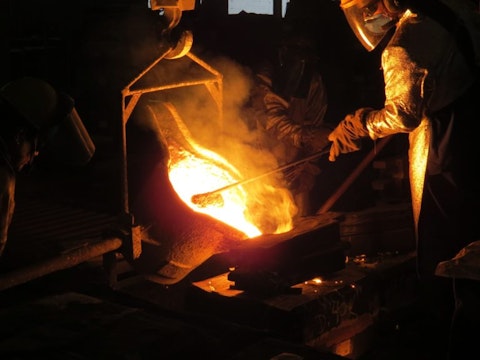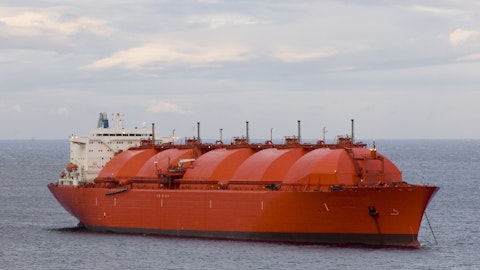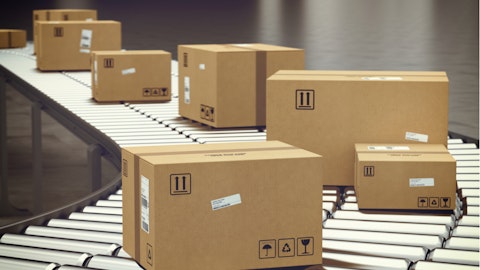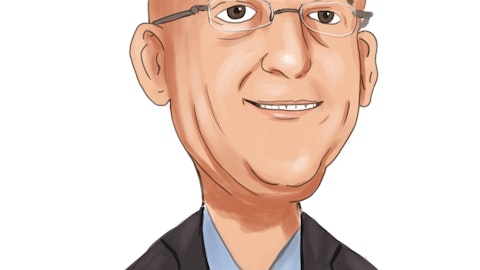Crown Holdings, Inc. (NYSE:CCK) Q1 2023 Earnings Call Transcript April 25, 2023
Crown Holdings, Inc. beats earnings expectations. Reported EPS is $1.2, expectations were $1.05.
Operator: Good morning. And welcome to Crown Holdings First Quarter 2023 Conference Call. Your lines have been placed on a listen-only until the question-and-answer session. Please be advised this conference is being recorded. I would now like to turn the call over to Mr. Kevin Clothier, Senior Vice President and Chief Financial Officer. Sir, you may begin.
Kevin Clothier: Thank you, Marcia , and good morning. With me on today’s call is Tim Donahue, President and Chief Executive Officer. If you do not already have the earnings release, it is available on our website at crowncork.com. On this call, as in the earnings release, we will be making a number of forward-looking statements. Actual results could vary materially from such statements. Additional information concerning factors that could cause actual results to vary is contained in the press release, in our SEC filings our Form 10-K for 2022 and subsequent filings. First quarter earnings were $0.85 a share, compared to $1.74 a share in the prior first quarter. Adjusted earnings per share were $1.20 in the quarter, compared to $2.01 in 2022.
Net sales in the quarter were down 6% from the prior year reflecting higher unit sales volumes in Americas Beverage, offset by lower unit volumes in most other businesses. The pass-through of approximately $100 million of lower raw material costs and $36 million from the impact of a stronger U.S. dollar. Segment income at $320 million in the quarter, compared to $383 million in the prior year and reflects the benefit of contractual recovery of prior year’s inflationary cost increases in European Beverage, cost reduction initiatives in Transit Packaging, offset by $60 million of year-over-year steel repricing in North America — in the North American Tinplate businesses. That is $48 million of gains in Q1 of 2022 versus $12 million of losses in Q1 of 2023.
We have better than expected first quarter and we remain optimistic for 2023. We reaffirm full year guidance as follows. We expect EBITDA to grow 8% to 12% and we expect full year adjusted EPS to be in the range of $6.20 and $6.40. Second quarter adjusted EPS is expected to be in a range of $1.60 per share to $1.70 per share. Our full year adjusted even guidance includes the following, which remains unchanged from our previous guidance. Net interest expense of $400 million in 2023, compared to $270 million in 2022, $0.40 of incremental non-cash pension and postretirement costs, average common shares outstanding to be approximately $120 million and the full year tax rate to be between 24% and 25%. Depreciation of approximately $350 million, compared to $301 million in 2022, non-controlling interest to be approximately $140 million and dividends to non-controlling interest are expected to be around $110 million.
Free cash flow is projected to be $500 million, with capital spending of $900 million. We expect the majority of free cash flow to go to debt reduction until we get within our target leverage ratio range of 3 times to 3.5 times. With that, I will turn the call over to Tim.
Tim Donahue: Thank you, Kevin, and good morning to everybody. I will be brief and then we will open the call for questions. As reflected in last night’s earnings release, and as Kevin just summarized, first quarter performance was better than expected on the back of stronger results in European Beverage and Transit Packaging. Compared to the prior year, net results were impacted by prior year steel repricing and higher interest and retirement benefit expenses. Global beverage can volumes were down 2.5% to the prior year and reflect the impact of an inflation-weary consumer, as well as economic slowdowns in some markets. From 2019 through the end of 2023, we will add — we will have added more than 25 billion units or 30%-plus of annualized beverage can capacity globally, from which to serve local and regional customers.
Our Americas and European Beverage can platforms are well positioned to continue to serve our customer’s diverse and growing needs. As discussed with you in February, and as Kevin just reiterated, we expect capital expenditures to approximate $500 million in 2024 with resulting incremental cash flows being used to delever and return cash to shareholders. In Americas Beverage, unit volume growth was 6% in the quarter, with North America up 4% and Brazil up 23% off an easy comp from Q1 of 2022. While promotional activity was lighter than anticipated in North America, we remain optimistic that summer selling season promotions will begin during the second quarter. We estimate the North American market was down 2% during the quarter, with the entirety of the decline found in imported cans, that is domestic producers were flat in total.
Importantly, from April 1st, the formulaic PPI increases are reflected in our selling prices, beginning the recovery of cost increases experienced over the past year. During the quarter, the second line at our new plant in Martinsville, Virginia, began commercial shipments and we expect the first line in Mesquite, Nevada to commence shipments in July, followed by the second line in October. During the first quarter, our Brazilian beverage can customers filed for bankruptcy protection and we have adjusted our Brazilian sales outlook for the balance of the year to reflect this specific customer situation. We believe the registered collateral provides adequate security for our receivable balance. Income in the segment is still expected to improve meaningfully for the full year, and as discussed previously, will be weighted towards the back half.

Photo by Francisco Fernandes on Unsplash
Unit volumes in European Beverage declined high-single digits during the quarter, with notable weakness experienced in Spain, Turkey and the U.K., primarily due to the impact of the earthquake in Turkey, retail price increases, as well as customers managing their working capital by deferring their purchase of cans closer to the summer selling season. Importantly, our efforts to restore margin with more appropriate contractual recovery mechanisms are underway, with the first quarter registering notable sequential improvement from the second half of 2022. We expect the business to continue to perform well with improvement expected year-over-year in each of the remaining three quarters of the year. Beverage can volumes in Asia-Pacific declined double digits, with declines noted in almost each market.
The impact of higher retail prices, inflation in general and slowing economies all contributed to lower overall demand. We do expect the segment’s income to approach prior year levels, albeit weighted towards the back half of the year. Income in Transit Packaging improved almost 30% over the prior year, as benefits from the overhead reduction program initiated last year, coupled with the mix benefit of selective pruning of lower-margin SKUs and accounts more than offset like-for-like volume declines. Margins were improved across commodity product lines and in equipment. As expected, headwinds from prior year inventory repricing gains, coupled with weak aerosol demand offset the benefit of higher food can sales driving income and other well below the prior year.
During the quarter, we made provision to right-size headcounts in our U.K. can-making equipment business to reflect lower expected activity. So, in summary, a solid start to the year and overhaul — overall ahead of plan. Looking ahead, we expect the second quarter will continue to reflect improving results in European Beverage and Transit with Americas Beverage beginning to show improvement by the third quarter. It’s still early in the year, so we maintain our earlier guidance range of 8% to 12% EBITDA growth despite the outperformance in the first quarter. And with that, Marcia, I think we are now ready to take questions.
See also 17 Best Gambling Stocks to Buy Now and 14 Best Affordable Tech Stocks to Buy Now.
Q&A Session
Follow Crown Holdings Inc. (NYSE:CCK)
Follow Crown Holdings Inc. (NYSE:CCK)
Operator: Thank you. Okay. We have the first question coming from the line of Christopher Parkinson from Mizuho. Your line is now open.
Christopher Parkinson: Great. Thank you so much. Could you just hit a little bit more on your specific performance in North America, I appreciate the market-driven remarks. But in terms of just what you are seeing in various substrates across energy, seltzer, non-alcoholic to be clear, CSD versus beer, and as well as the ready-to-drink launches. If you could just break things down and articulate how you see those substrates developing throughout the year and what that means for Crown, specifically? That would be greatly appreciated. Thank you so much.
Tim Donahue: You are welcome. So I think that, in North America specifically we are not very big in beer. We have a significant craft beer presence in Canada, but in the United States, not very big in beer. We do supply some beer. So I am going to stay away from beer for the time being. I think you are going to continue to see ready-to-drink energy drinks. Those new launches, those new lines continue to grow, albeit off smaller bases than the bigger products that move volume. So for example, carbonated soft drink, teas, sparkling water. I think we will see sparkling water do okay. Carbonated soft drinks, I think, is going to be largely centered around the level of promotional activity we see over the balance of the year. And as Kevin said, we remain optimistic and albeit a little ahead of our earlier forecast here in Q1, but not adjusting our full year estimate only because until we see some sign of larger promotional activity, it’s really hard to step up — step out and adjust the full year.
We will get a chance to do that again in July if we need to. But I think everything revolves around CSD promotions and we better start seeing that by the middle of May, before the Memorial Day holiday and straight through to the middle of June ahead of the July 4th holiday.
Christopher Parkinson: That’s helpful. And just turning over to the Asian market. One of — what I presume to be one of your regional customers has been citing the fact that underlying demand growth has been very, very healthy, but obviously, there’s a bit of a destock going on between the fourth quarter and the first quarter. So if you could just hit on the underlying demand trends in that marketplace. What that meant for the first quarter versus what it means for the remainder of the year would also be incredibly helpful? Thank you so much.
Tim Donahue: Yeah. So I think we have two different issues in Asia. One, the — as we described for you in February, the Cambodian market is exceptionally weak. A big part of their economy relates to the textile industry, with exports to Europe and elsewhere around the world and that industry is struggling and as the Cambodian consumer and certain industries in Cambodia struggle, can sales are down. The issue you referred to, with the one customer you are referring to has to do with the inventory, the filled good inventory that was built ahead of Chinese New Year. The sell-through at Chinese New Year was not as strong as they and others had hoped. So there still is a fair amount of filled inventory in the system that has to be cleared out.
The slowness of the Chinese New Year and the wedding season in certain countries in Asia, largely a result of a stressed consumer and so we will see where that takes us. But I think we will see, as we get into the back half of the second quarter into the third quarter, we will start to see some recovery in most of those markets, specifically Vietnam.
Christopher Parkinson: Thank you.
Tim Donahue: You are welcome.
Operator: Thank you. We have the next question coming from the line of Ghansham Panjabi from Baird. Your line is now open.
Ghansham Panjabi: Hey, guys. Good morning.
Tim Donahue: Good morning, Ghansham.
Kevin Clothier: Good morning.
Ghansham Panjabi: Yeah. Good morning. I guess, first off, maybe you can give us a sense as to beverage can volumes in Europe as an industry. I know you broke that out for yourself, your geographic mix is a little bit different with Turkey, et cetera. So just give us some color in Continental Europe in terms of what you have seen? And then some of your customers that have been reporting have pointed towards the consumer there just being increasingly cautious in terms of spending and so on and so forth, trading down, et cetera., how do you see the year unfolding for that region for you?
Tim Donahue: So, I think, I agree with everything you just said, Ghansham. I think beer has been exceptionally weak to start the year in Europe. Let’s put the earthquake in Turkey aside. Let’s just deal with the balance of Europe and for the most part, we are on the perimeter. We are not really up through the center of the heart of Europe. So when we say the perimeter, we mean U.K., Spain, Italy, Greece, et cetera. So, but beer has been exceptionally weak. I think the consumer, specifically the U.K. consumer, is struggling with food inflation the rate of inflation and the size of inflation over the last couple of years for food in the U.K. is exceptionally high. And then, lastly, as I pointed out, we are seeing customers trying to defer their purchases of cans as long as they can closer to the summer to manage their own working capital and their own interest costs.
But so putting all that aside, I do think we are going to have a reasonable summer. We will cycle through this working capital issue and we will have a reasonable summer. We will see if we have enough. If they try to buy all the cans in the summer that they should have bought some in February, March and April, they wait to buy them all. We will see if we have enough hands for all of them, but it should be a reasonable summer through the end of the third quarter. We are going to do, let’s be clear. The most important thing that we were looking to accomplish this year in Europe was to adjust the contracts to appropriately recover our costs and derisk our position in the contract. We don’t sell to the consumer. We do not have any pricing power with the consumer.
We need to get it from our customers or we don’t get it and I think we have accomplished that. So the first goal is to make money. Well, the first goal is obviously to serve your customers. The second goal is to make money. And if we don’t make money, we are not going to be good with the first goal. So I think we have accomplished adjusting the contracts. We are going to have a good year despite whatever the volume happens here, so.
Ghansham Panjabi: Okay. Got it. And then for my second question, going back to North America. I mean, obviously, 1Q is a very small quarter. There’s a lot of complexity on the horizon, et cetera, as it relates to the outlook for the consumer in the U.S. Are customers — have they rebased our expectations for volumes just based on your conversations with them for 2023 relative to initial plan or did they see the year sort of unfolding pretty much in line at this point?
Tim Donahue: Yeah. So I think if they were being honest, they may tell us that they over sourced cans among Crown and the other can suppliers. I think we kind of feel we know where they are at, but again, it’s largely dependent upon promotions, right? We have seen some promotions but few and far between and not at levels, which drive the consumer to stock up on cans and consume more of the products that our customers are selling. So they are — as they were last year, they are — I don’t know if they are satisfied, but they are reporting lower volumes and higher profits and that’s a formula that works. So we understand that. We understood it as the year unfolded last year. We understood it better. And we understand it from where we are at today. So we have to deal with that changing dynamic in our end markets.
Ghansham Panjabi: Got it. Thanks so much, Tim.
Tim Donahue: Thank you.
Operator: Thank you. The next question comes from the line of Mike Leithead from Barclays. Your line is now open.
Mike Leithead: Great. Thanks. Good morning, guys.
Tim Donahue: Good morning.
Mike Leithead: First question, Tim, just two real quick on North American Beverage. First, can you just talk about what gives you confidence in the summer promotional activity hopefully occurring in this year versus not really occurring last year? And second, do you still expect to be up 10% in North America this year?
Tim Donahue: Well, I think what we said, Mike, was that if the market is flat, we will be up 10% and I think we were pretty clear that if the market is down, we probably don’t make 10%. If the market’s up, we are probably a little better than 10%. So let’s see where the market takes us. We were always more heavily weighted in volume growth towards the second and third quarters as more capacity came up. So I don’t think we are behind our original expectations with 4% in Q1, although we are going to need to see some promotions to drive more sales at the retail level.




